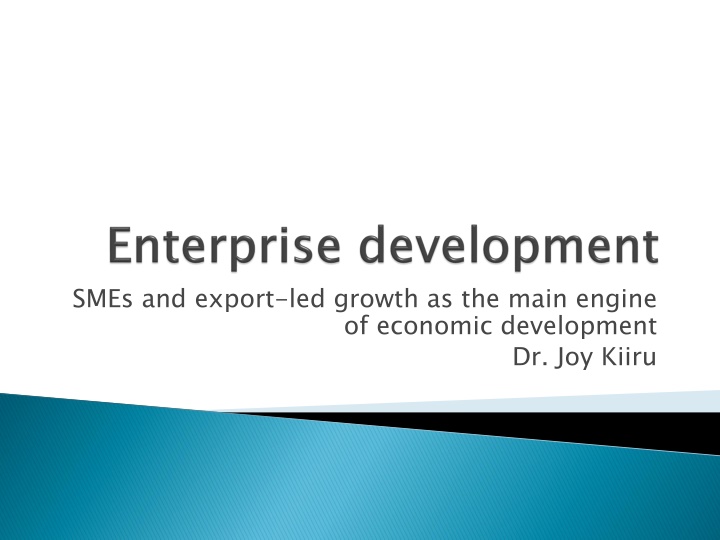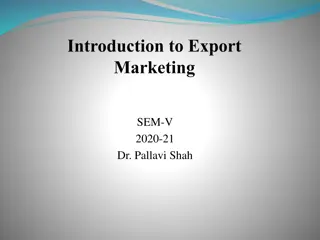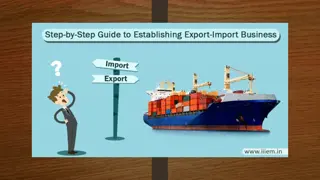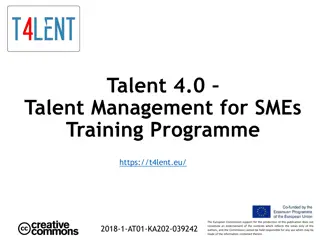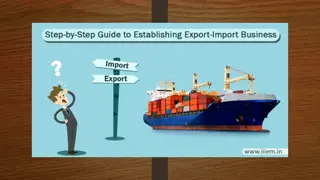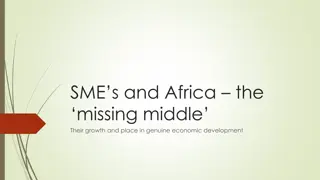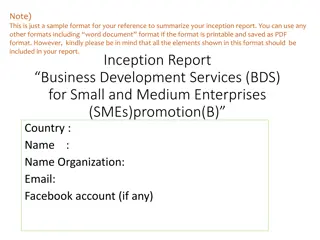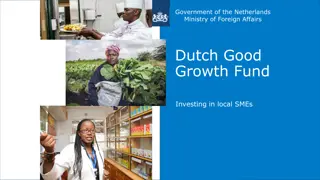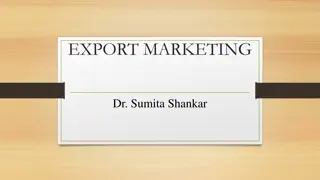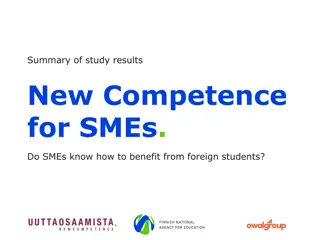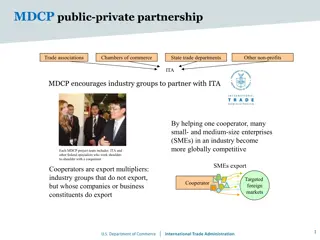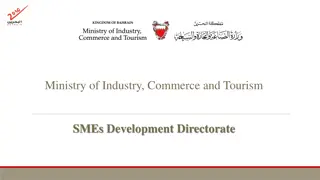SMEs and Export-Led Growth for Economic Development
SMEs play a critical role in economic development worldwide, with a significant impact on GDP and employment. In Africa, SMEs represent the majority of businesses and employment, particularly in the informal sector. However, these enterprises face internal and external challenges such as access to finance, innovation, and market limitations that hinder their growth potential. Access to finance is identified as a crucial factor in overcoming these obstacles and driving innovation and development within SMEs.
Download Presentation

Please find below an Image/Link to download the presentation.
The content on the website is provided AS IS for your information and personal use only. It may not be sold, licensed, or shared on other websites without obtaining consent from the author.If you encounter any issues during the download, it is possible that the publisher has removed the file from their server.
You are allowed to download the files provided on this website for personal or commercial use, subject to the condition that they are used lawfully. All files are the property of their respective owners.
The content on the website is provided AS IS for your information and personal use only. It may not be sold, licensed, or shared on other websites without obtaining consent from the author.
E N D
Presentation Transcript
SMEs and export-led growth as the main engine of economic development Dr. Joy Kiiru
Enterprise development is about growing existing companies rather than developing start-ups It is enterprise development that drives productivity growth. It Involves: -Enabling environment for small enterprise growth -Support services: both financial and non financial
Critical economic role. They account for about half of global gross domestic product ( GDP ) and create 60 % 70 % of employment. In the OECD area, SMEs employ more than half of the labour force in the private sector. In the European Union, they account for over 99 % of all enterprises. Furthermore, 91 % of these enterprises are micro-firms with less than 10 workers
In Africa they represent more than 90 % of businesses and employ about 60 % of workers, many of whom are women The informal sector generates about 55 % of sub-Saharan Africa s GDP and employs around 80 % of the labour force.
83% (2017) of total labour force (13.3 million) is employed in the informal sector through SMEs. Accounts for 30% of GDP Popularly known as the Jua Kali Sector, small- scale activities that are semi-organised, unregulated
There are both internal and external factors that constrain SMES. Internal: innovation, rapid changes in technology, managerial skills and human capital External factors: Access to finance, information, infrastructural development (connectivity), limited market access
Access to finance is rated higher financial capability of a firm plays a big role in addressing even the more paramount internal challenges For example, to innovate or to acquire human capital or technology a firm requires financial resources.
Government (Kenya) attempts to address these challenges include: -Local content Policy for public projects, Buy Kenya, Build Kenya policies in public procurement, -Research and development support -Increased contributions to funds such as the Uwezo fund that aims to expand access to finances and promote women, youth and persons living with a disability. Youth Fund
A study to build capacity within Kenyas financial services sector to SMEs (2016), showed banks were not serving SMEs effectively. There is demand for both financial and non financial services by SMES in Kenya
Non financial support is often referred to as business development services or BDS (advisory services, training and information as well as business clubs and other networking events). Some commercial banks have been active in such initiatives, but very much as part of their charitable or corporate social responsibility (CSR) activities.
KCB (Kenya Commercial Bank Limited) has set aside 60% of its Foundation s budget to promoting enterprise development with a focus on agribusinesses and youth enterprise. Equity Bank Group s Foundation focuses on innovation and entrepreneurship in order to stimulate job creation and economic growth by providing micro and small entrepreneurs with advisory services, mentoring, and business development training . They pay particular attention to working with young people and women
The impression of Non financial services towards the micro is more charitable There is however a serious role for NFS as part of commercial bank offering to the medium and small scale enterprise sector NFS are used to raise a financial institutions profile, attract new clients, offered as extras or bonuses to retain existing clients and used in a developmental way to help smaller business clients grow their businesses and through this take up a wider range of the financial solutions that FIs can provide.
Customised approaches are offered to those SMEs which have grown or who can demonstrate growth potential. These services are offered through bank relationship managers They provide information and Knowledge, (publications, business clubs, sme related events), Training programmes, (Banks supporting training for their SME customers do so by working in partnership with educational and training institutions and/ or private trainers)
Equity Bank in Kenya offers sector specialist support for their medium sized enterprise clients as well as investment readiness mentoring for those considering equity investment.
A 2015 on the SME banking offers of 30 banks in Kenya, found that just over a quarter (26%) of the banks said they provided NFS for their SME clients; yet there is demand for these services by SMEs A 2013 report on SME development in South Africa noted a strong unmet demand for business NFS amongst SME owners. Recent research with growth SMEs in Kenya acknowledged the desire by entrepreneurs for similar support.
In order to target growth oriented SMES there is need to go beyond the traditional provision of credit (Expensive) through traditional bank loans
Indeed there is evidence that SMEs could become more competitive by increasing their involvement in foreign markets, as internationalized enterprises typically report higher sales and growth Evidence suggests that SME exporters grow 4 % faster than non-exporters
There is a missing middle in business financing Wide variety of funding vehicles for micro- enterprise, and larger investments, there is a gap in the availability of accessible finance at a scale of growth oriented SMEs. Banks have an opportunity to connect such SMEs to international markets through trade finance
Kenyas trade pattern shows dynamic development with yearly increases. A large part of this trade is directed towards the East African Region, supported by Kenya s membership in the East African Community (EAC) and Common Market for Eastern and Southern Africa (COMESA). The rest of the trade is directed towards Europe (about 23%), then Asia (of growing importance for imports), the Middle East and the USA.
Trade finance represents the financial instruments and products that are used by companies to facilitate international trade and commerce. Trade finance makes it possible and easier for importers and exporters to transact business through trade.
The function of trade finance is to introduce a third-party to transactions to remove the payment risk and the supply risk. Trade finance provides the exporter with receivables or payment according to the agreement while the importer might be extended credit to fulfill the trade order.
Letters of credit reduce the risk associated with global trade since the buyer's bank guarantees payment to the seller for the goods shipped. Factoring is when companies are paid based on a percentage of their accounts receivables. Export credit or working capital can be supplied to exporters. Insurance can be used for shipping and the delivery of goods and can also protect the exporter from non-payment by the buyer.
Besides reducing the risk of non-payment and non-receipt of goods, trade finance has become a important tool for growth oriented SMEs to improve their efficiency and boost revenue
